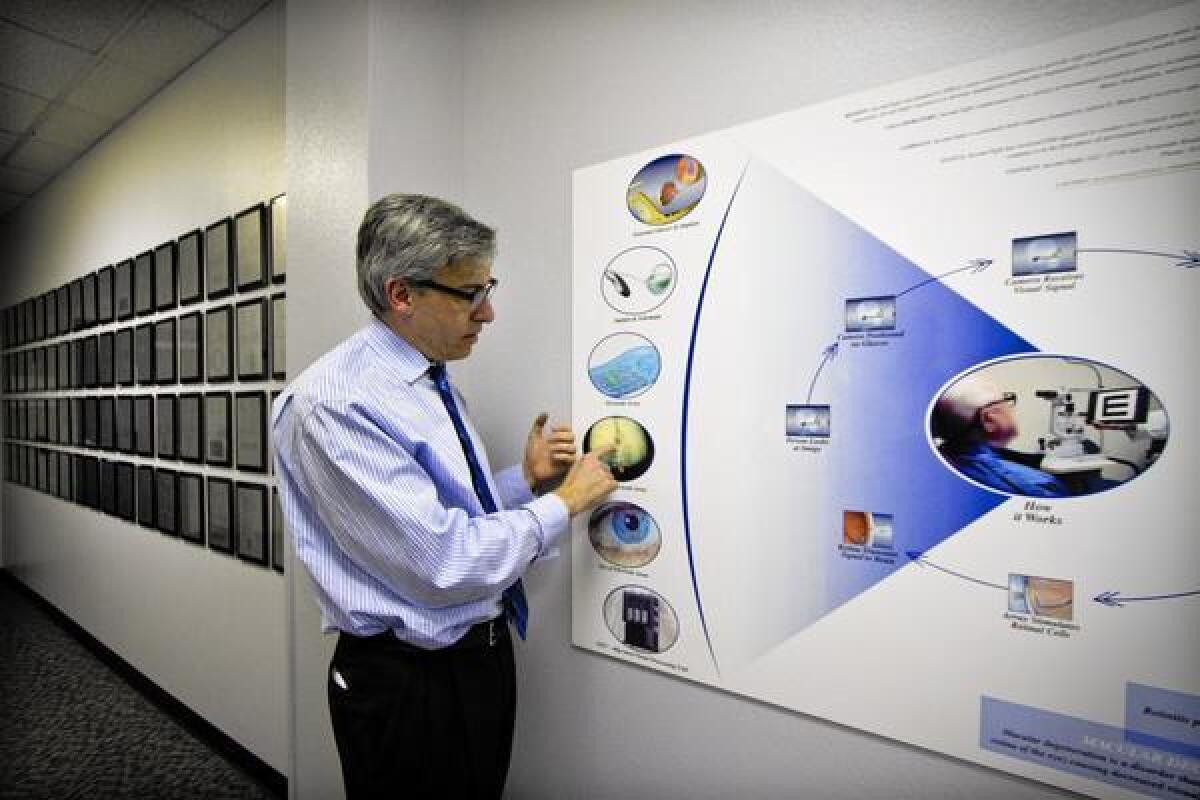With ‘bionic eye’ booming, Second Sight is on analysts’ radar

- Share via
Second Sight Medical Products Inc. designs, makes and sells the Argus II Retinal Prosthesis System, which gives sight to the blind. And sales of the “bionic eye” are on the rise.
Argus II is a prosthetic retina for people with a disease called retinitis pigmentosa. The device looks like futuristic sunglasses paired with a small box, which contains the brains of the device — a video processing unit.
A miniature video camera captures an image and then transmits that image to the video processing unit, which then sends it to electrodes implanted in a patient’s retina using a surgical procedure.
Argus II does not restore normal vision. But it does allow the wearer to see light and shapes, sometimes for the first time in decades.
More than 100 patients have received the Argus II, with 15 systems implanted during the last three months of 2014, the most of any quarter. The earliest recipients have had the implants for nearly eight years.
Second Sight has received regulatory approvals to offer the device in the U.S., Canada and the European Union. Patients have received the device in the U.S. and 10 other countries.
Company executives think the device has a potential market of more than 8 million people, including 375,000 with retinitis pigmentosa and 2 million with age-related macular degeneration.
The company said its products are so far ahead of rivals in regulatory approval and patent protections that competitors will have a difficult time playing catch-up.
“We have solved several very difficult technical problems,” Chief Executive Robert Greenberg said Wednesday in a conference call with analysts.
“The patents surrounding these solutions coupled with the difficulty of the solutions provide a significant barrier to entry and, in our opinion, at least a five-year lead over our closest competitors,” Greenberg said.
Second Sight was founded in 1998 by Alfred E. Mann, Sam Williams and Gunnar Bjorg. Clinical trials began in 2002; the Food and Drug Administration approved the product in 2013.
Billionaire entrepreneur Mann, who is the company’s chairman, also founded MannKind Corp., which last year won FDA approval for an inhaled insulin drug called Afrezza.
Second Sight went public in November, raising net proceeds of $34 million.
Retinitis pigmentosa is a hereditary disease that affects about 1.5 million people worldwide, including about 100,000 people in the United States, Second Sight said in its IPO filing with the Securities and Exchange Commission.
The latest
Second Sight on Wednesday posted a fourth-quarter net loss of $13.6 million compared with a net loss of $6 million a year earlier. Much of the wider loss was attributed to $8.4 million in non-cash charges related to the company’s stock offering.
Revenues were up, to $1.5 million in the fourth quarter from $563,363 a year earlier.
In recent weeks, Second Sight announced that it had performed the first implants on patients in Italy and France.
In January, Second Sight said that Health Canada — the government department that oversees that country’s public health system — had approved Argus II for the treatment of outer retinal degeneration.
Accomplishments
Second Sight’s Argus II is the first approved retinal prosthesis in the world.
Cleveland Clinic gave Second Sight its Top Medical Innovation of 2014 award.
Also in 2014, the company was selected as a gold winner in the science/medical category by Edison Awards and as a Technology Pioneer by the World Economic Forum.
Challenges
The Argus II is very expensive at about $100,000 in Europe and $140,000 in the U.S.
Analysts
Analysts have only recently begun to follow the company.
Twitter: @RonWLATimes
More to Read
Inside the business of entertainment
The Wide Shot brings you news, analysis and insights on everything from streaming wars to production — and what it all means for the future.
You may occasionally receive promotional content from the Los Angeles Times.









